Exploration of the hepatoprotective effect and mechanism of magnesium isoglycyrrhizinate in mice with arsenic trioxide‑induced acute liver injury
- Authors:
- Miaomiao Liu
- Bin Zheng
- Panpan Liu
- Jianping Zhang
- Xi Chu
- Chunhui Dong
- Jing Shi
- Yingran Liang
- Li Chu
- Yanshuang Liu
- Xue Han
-
Affiliations: Department of Pharmacology, School of Pharmacy, Hebei University of Chinese Medicine, Shijiazhuang, Hebei 050200, P.R. China, Department of Pharmacology, School of Basic Medicine, Hebei University of Chinese Medicine, Shijiazhuang, Hebei 050200, P.R. China, Department of Pharmacy, The Fourth Hospital of Hebei Medical University, Shijiazhuang, Hebei 050011, P.R. China, Hebei Key Laboratory of Integrative Medicine on Liver‑Kidney Patterns, Institute of Integrative Medicine, College of Integrative Medicine, Hebei University of Chinese Medicine, Shijiazhuang, Hebei 050200, P.R. China - Published online on: April 9, 2021 https://doi.org/10.3892/mmr.2021.12077
- Article Number: 438
-
Copyright: © Liu et al. This is an open access article distributed under the terms of Creative Commons Attribution License.
This article is mentioned in:
Abstract
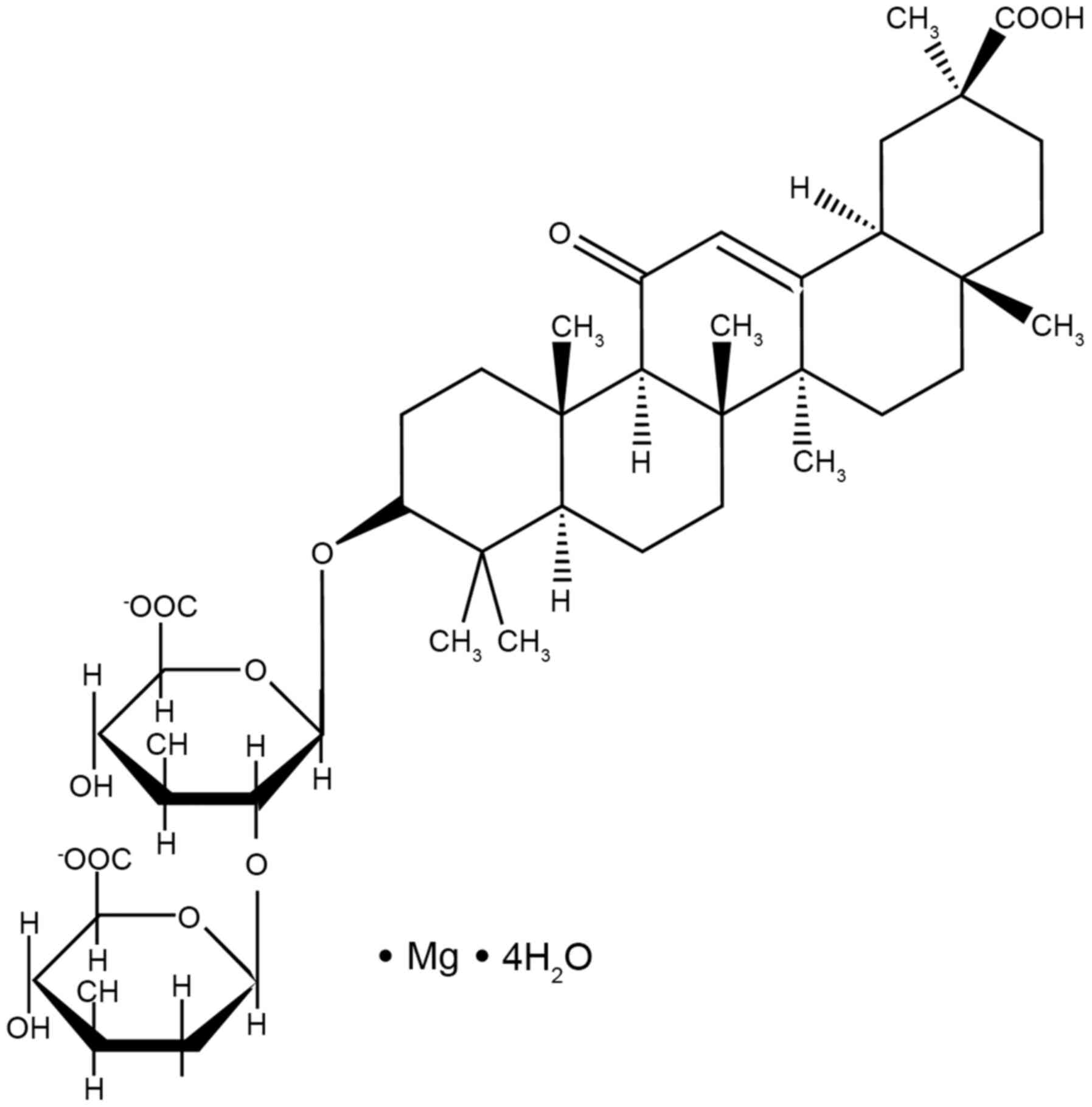 |
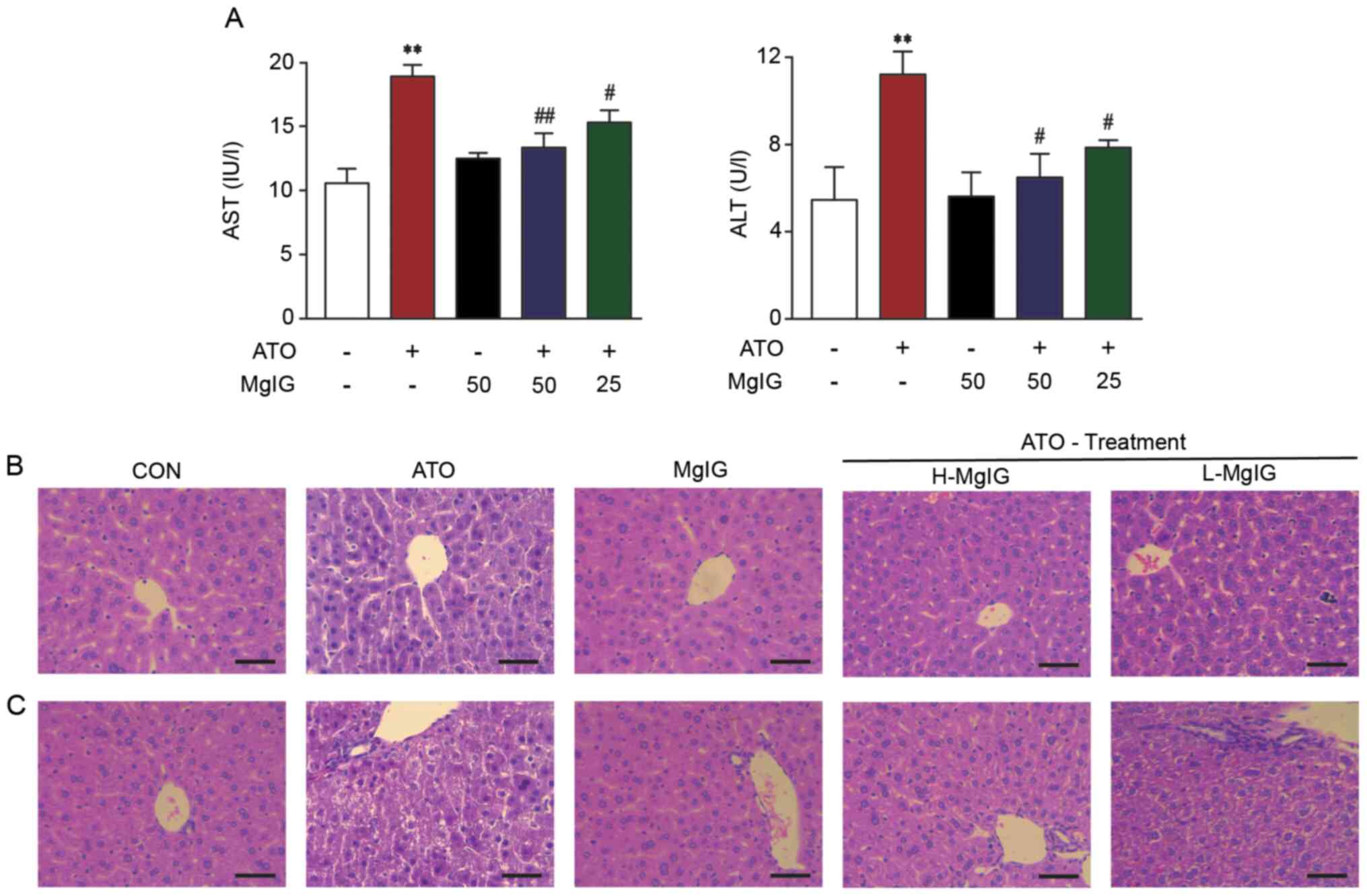 |
 |
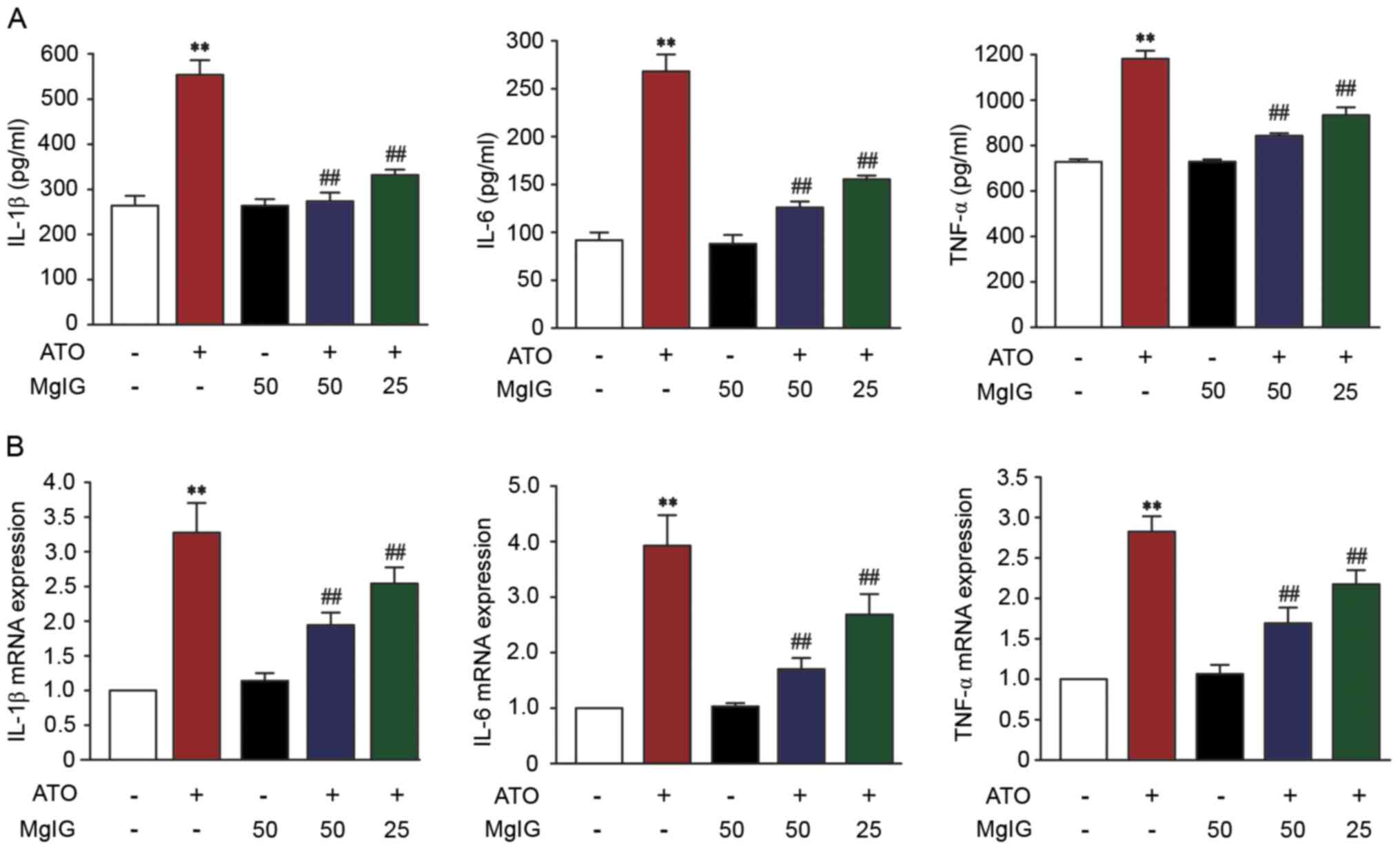 |
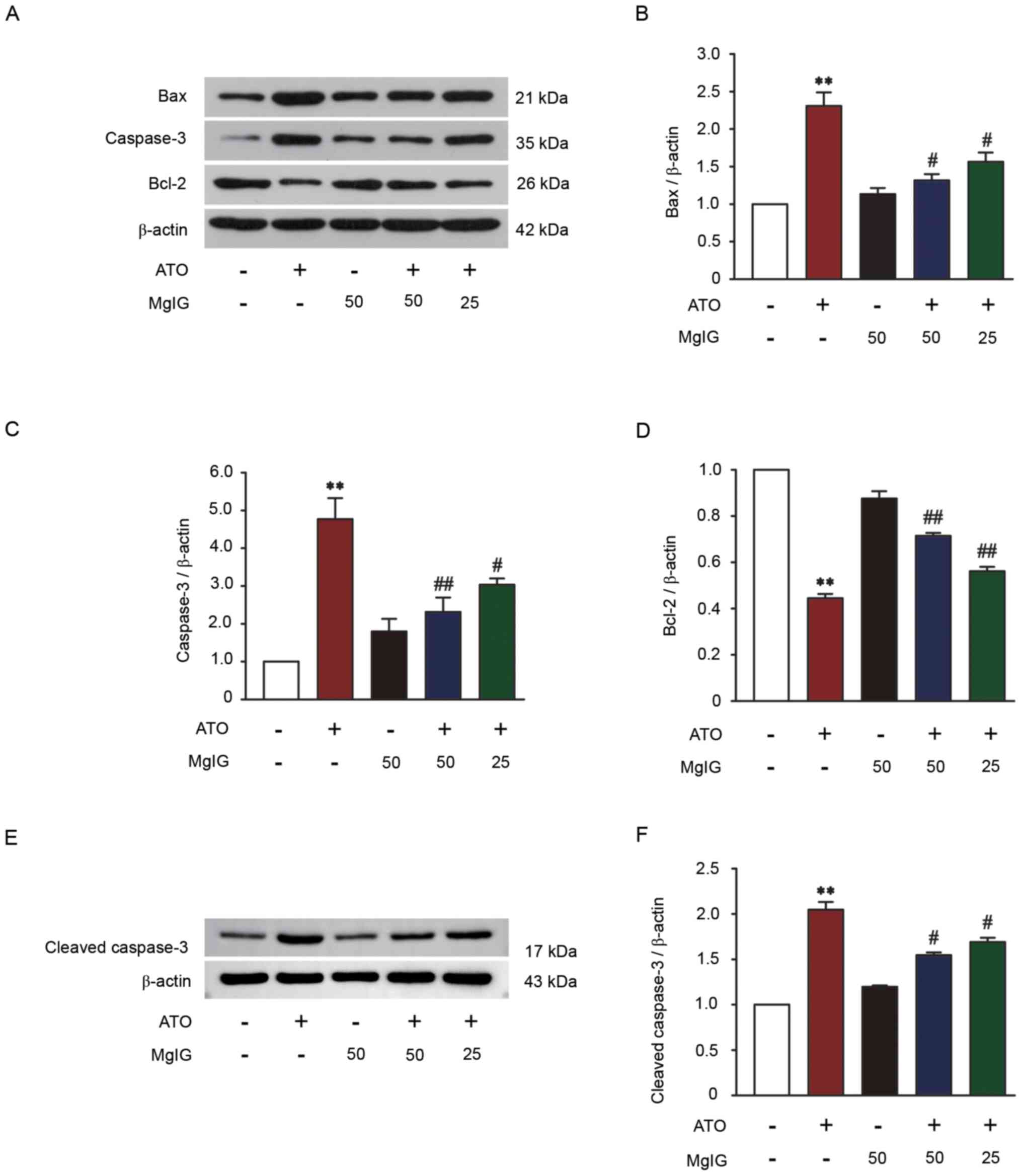 |
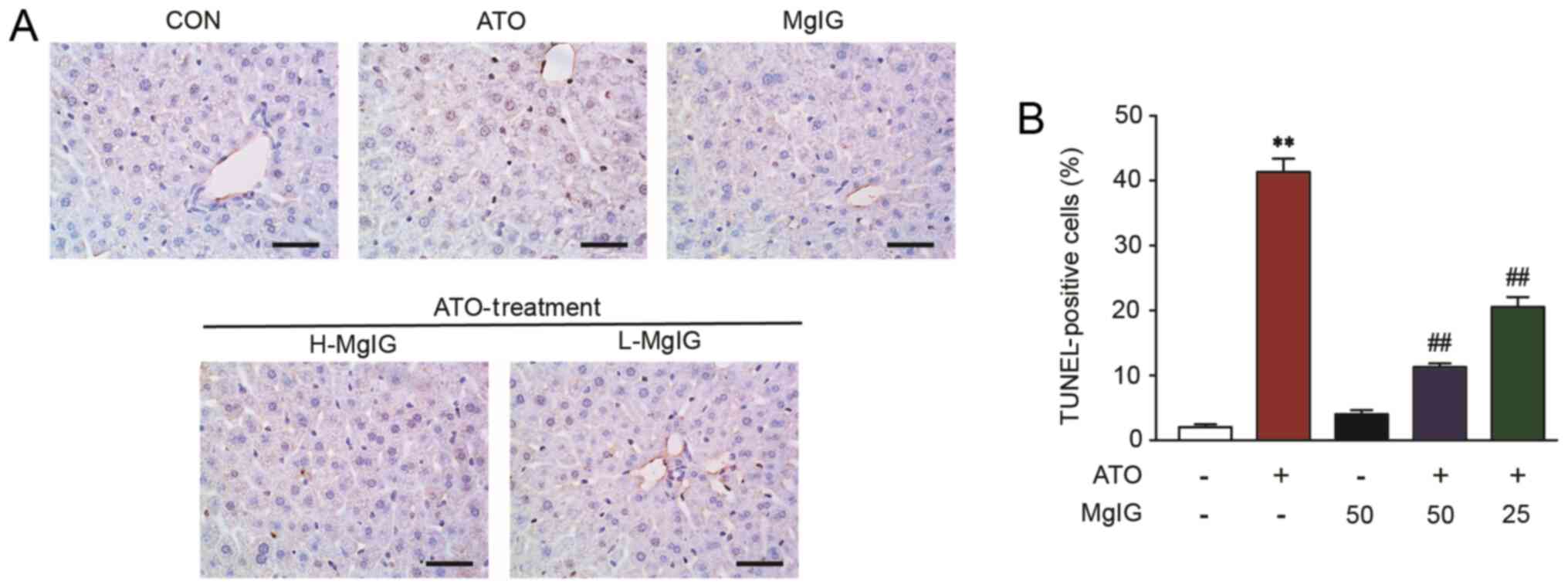 |
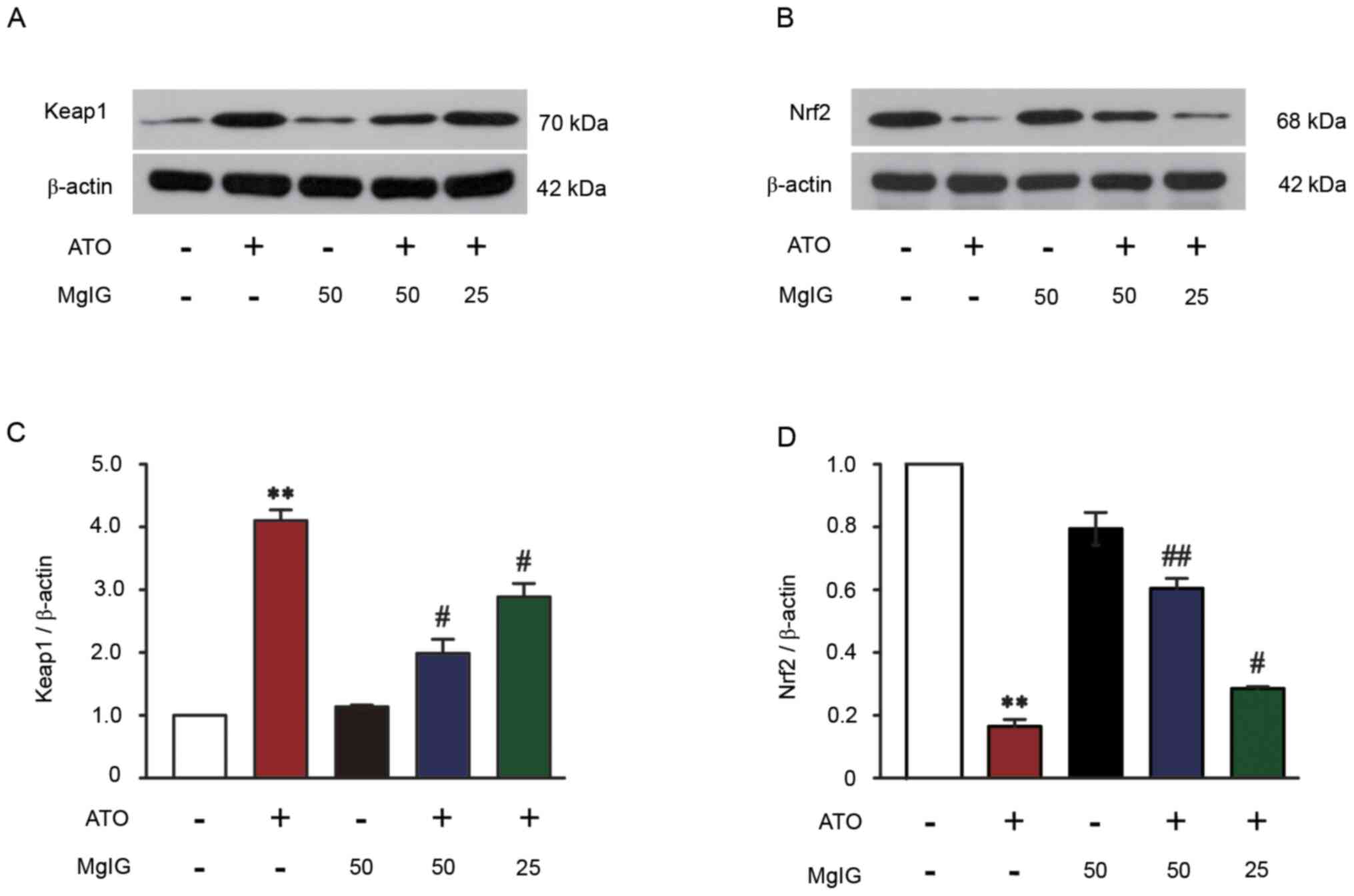 |
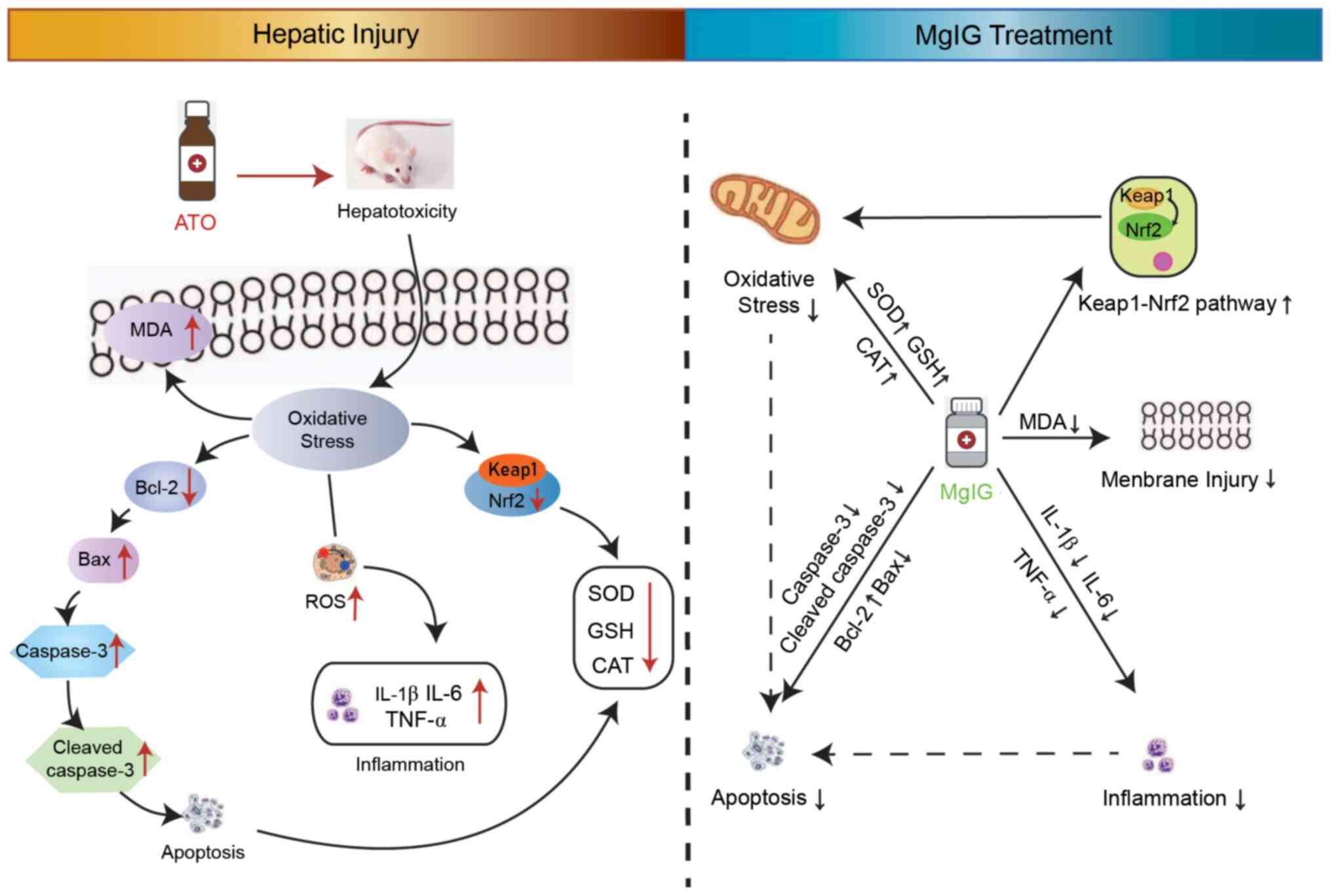 |
|
Centeno JA, Mullick FG, Martinez L, Page NP, Gibb H, Longfellow D, Thompson C and Ladich ER: Pathology related to chronic arsenic exposure. Environ Health Persp. 110 (Suppl 5):S883–S886. 2002. View Article : Google Scholar | |
|
Emadi A and Gore SD: Arsenic trioxide-An old drug rediscovered. Blood Rev. 24:191–199. 2010. View Article : Google Scholar : PubMed/NCBI | |
|
Gore SD, Gojo I, Sekeres MA, Morris L, Devetten M, Jamieson K, Redner RL, Arceci R, Owoeye I, Dauses T, et al: Single cycle of arsenic trioxide-based consolidation chemotherapy spares anthracycline exposure in the primary management of acute promyelocytic leukemia. J Clin Oncol. 28:1047–1053. 2010. View Article : Google Scholar : PubMed/NCBI | |
|
Antman KH: Introduction: The history of arsenic trioxide in cancer therapy. Oncologist. 6 (Suppl 2):S1–S2. 2001. View Article : Google Scholar | |
|
Abaza Y, Kantarjian H, Garcia-Manero G, Estey E, Borthakur G, Jabbour E, Faderl S, O'Brien S, Wierda W, Pierce S, et al: Long-term outcome of acute promyelocytic leukemia treated with all trans-retinoic acid, arsenic trioxide, and gemtuzumab. Blood. 129:1275–1283. 2017. View Article : Google Scholar : PubMed/NCBI | |
|
Breccia M and Lo-Coco F: Arsenic trioxide for management of acute promyelocytic leukemia: Current evidence on its role in front-line therapy and recurrent disease. Expert Opin Pharmacother. 13:1031–1043. 2012. View Article : Google Scholar : PubMed/NCBI | |
|
Iland HJ, Bradstock K, Supple SG, Catalano A, Collins M, Hertzberg M, Browett P, Grigg A, Firkin F, Hugman A, et al: All-trans-retinoic acid, idarubicin, and IV arsenic trioxide as initial therapy in acute promyelocytic leukemia (APML4). Blood. 120:1570–1580; quiz 1752. 2012. View Article : Google Scholar : PubMed/NCBI | |
|
Lo-Coco F, Avvisati G, Vignetti M, Thiede C, Orlando SM, Iacobelli S, Ferrara F, Fazi P, Cicconi L, Di Bona E, et al: Retinoic acid and arsenic trioxide for acute promyelocytic leukemia. N Engl J Med. 369:111–121. 2013. View Article : Google Scholar : PubMed/NCBI | |
|
Zhang X, Jia S, Yang S and Yang Y, Yang T and Yang Y: Arsenic trioxide induces G2/M arrest in hepatocellular carcinoma cells by increasing the tumor suppressor PTEN expression. J Cell Biochem. 113:3528–3535. 2012. View Article : Google Scholar : PubMed/NCBI | |
|
Walker AM, Stevens JJ, Ndebele K and Tchounwou PB: Evaluation of arsenic trioxide potential for lung cancer treatment: Assessment of apoptotic mechanisms and oxidative damage. J Cancer Sci Ther. 8:1–9. 2016. View Article : Google Scholar : PubMed/NCBI | |
|
Messarah M, Klibet F, Boumendjel A, Abdennour C, Bouzerna N, Boulakoud MS and El Feki A: Hepatoprotective role and antioxidant capacity of selenium on arsenic-induced liver injury in rats. Exp Toxicol Pathol. 64:167–174. 2012. View Article : Google Scholar : PubMed/NCBI | |
|
Miller WH Jr, Schipper HM, Lee JS, Singer J and Waxman S: Mechanisms of action of arsenic trioxide. Cancer Res. 62:3893–3903. 2002.PubMed/NCBI | |
|
Jin W, Xue Y, Xue Y, Han X, Song Q, Zhang J, Li Z, Cheng J, Guan S, Sun S and Chu L: Tannic acid ameliorates arsenic trioxide-induced nephrotoxicity, contribution of NF-κB and Nrf2 pathways. Biomed Pharmacother. 126:1100472020. View Article : Google Scholar : PubMed/NCBI | |
|
Liu Y, Liang Y, Zheng B, Chu L, Ma D, Wang H, Chu X and Zhang J: Protective effects of crocetin on arsenic trioxide-induced hepatic injury: Involvement of suppression in oxidative stress and inflammation through activation of Nrf2 signaling pathway in rats. Drug Des Dev Ther. 14:1921–1931. 2020. View Article : Google Scholar | |
|
Li M, Liu P, Xue Y, Liang Y, Shi J, Han X, Zhang J, Chu X and Chu L: Tannic acid attenuates hepatic oxidative stress, apoptosis and inflammation by activating the Keap1Nrf2/ARE signaling pathway in arsenic trioxide-toxicated rats. Oncol Rep. 44:2306–2316. 2020.PubMed/NCBI | |
|
Benramdane L, Accominotti M, Fanton L, Malicier D and Vallon JJ: Arsenic speciation in human organs following fatal arsenic trioxide poisoning-a case report. Clin Chem. 45:301–306. 1999. View Article : Google Scholar : PubMed/NCBI | |
|
Xu M, Rui D, Yan Y, Xu S, Niu Q, Feng G, Wang Y, Li S and Jing M: Oxidative damage induced by arsenic in mice or rats: A systematic review and meta-analysis. Biol Trace Elem Res. 176:154–175. 2017. View Article : Google Scholar : PubMed/NCBI | |
|
Valko M, Morris H and Cronin MT: Metals, toxicity and oxidative stress. Curr Med Chem. 12:1161–1208. 2005. View Article : Google Scholar : PubMed/NCBI | |
|
Alam MF, Khan G, Safhi MM, Alshahrani S, Siddiqui R, Sivagurunathan Moni S and Anwer T: Thymoquinone ameliorates doxorubicin-induced cardiotoxicity in swiss albino mice by modulating oxidative damage and cellular inflammation. Cardiol Res Pract. 2018:14830412018. View Article : Google Scholar : PubMed/NCBI | |
|
Kim SY, Park C, Jang HJ, Kim BO, Bae HW, Chung IY, Kim ES and Cho YH: Antibacterial strategies inspired by the oxidative stress and response networks. J Microbiol. 57:203–212. 2019. View Article : Google Scholar : PubMed/NCBI | |
|
Sies H and Jones DP: Reactive oxygen species (ROS) as pleiotropic physiological signalling agents. Nat Rev Mol Cell Biol. 21:363–383. 2020. View Article : Google Scholar : PubMed/NCBI | |
|
Mortezaee K and Khanlarkhani N: Melatonin application in targeting oxidative-induced liver injuries: A review. J Cell Physiol. 233:4015–4032. 2018. View Article : Google Scholar : PubMed/NCBI | |
|
Grossini E, Bellofatto K, Farruggio S, Sigaudo L, Marotta P, Raina G, De Giuli V, Mary D, Pollesello P, Minisini R, et al: Levosimendan inhibits peroxidation in hepatocytes by modulating apoptosis/autophagy interplay. PLoS One. 10:e01247422015. View Article : Google Scholar : PubMed/NCBI | |
|
Weiskirchen R and Tacke F: Relevance of autophagy in parenchymal and non-parenchymal liver cells for health and disease. Cells. 8:162019. View Article : Google Scholar : PubMed/NCBI | |
|
Barrera C, Valenzuela R, Rincon MA, Espinosa A, Echeverria F, Romero N, Gonzalez-Mañan D and Videla LA: Molecular mechanisms related to the hepatoprotective effects of antioxidant-rich extra virgin olive oil supplementation in rats subjected to short-term iron administration. Free Radic Biol Med. 126:313–321. 2018. View Article : Google Scholar : PubMed/NCBI | |
|
Chayapong J, Madhyastha H, Madhyastha R, Nurrahmah QI, Nakajima Y, Choijookhuu N, Hishikawa Y and Maruyama M: Arsenic trioxide induces ROS activity and DNA damage, leading to G0/G1 extension in skin fibroblasts through the ATM-ATR-associated Chk pathway. Environ Sci Pollut Res Int. 24:5316–5325. 2017. View Article : Google Scholar : PubMed/NCBI | |
|
Nili-Ahmadabadi A, Alibolandi P, Ranjbar A, Mousavi L, Nili-Ahmadabadi H, Larki-Harchegani A, Ahmadimoghaddam D and Omidifar N: Thymoquinone attenuates hepatotoxicity and oxidative damage caused by diazinon: An in vivo study. Res Pharm Sci. 13:500–508. 2018. View Article : Google Scholar : PubMed/NCBI | |
|
Hu JP, Zhao XP, Ma XZ, Wang Y and Zheng LJ: Effects of cigarette smoke on aerobic capacity and serum MDA content and SOD activity of animal. Int J Clin Exp Med. 7:4461–4465. 2014.PubMed/NCBI | |
|
Shafik NM and El Batsh MM: Protective effects of combined selenium and punica granatum treatment on some inflammatory and oxidative stress markers in arsenic-induced hepatotoxicity in rats. Bio Trace Elem Res. 169:121–128. 2016. View Article : Google Scholar | |
|
Sharanek A, Burban A, Ciriacim N and Guillouzo A: Pro-inflammatory cytokines enhance dilatation of bile canaliculi caused by cholestatic antibiotics. Toxicol In Vitro. 58:51–59. 2019. View Article : Google Scholar : PubMed/NCBI | |
|
Tu C, Gao D, Li XF, Li CY, Li RS, Zhao YL, Li N, Jia GL, Pang JY, Cui HR, et al: Inflammatory stress potentiates emodin-induced liver injury in rats. Front Pharmacol. 6:2332015. View Article : Google Scholar : PubMed/NCBI | |
|
Zhang J, Zhang Y, Wang W, Li C and Zhang Z: Double-sided personality: Effects of arsenic trioxide on inflammation. Inflammation. 41:1128–1134. 2018. View Article : Google Scholar : PubMed/NCBI | |
|
Dugo EB, Yedjou CG, Stevens JJ and Tchounwou PB: Therapeutic potential of arsenic trioxide (ATO) in treatment of hepatocellular carcinoma: Role of oxidative stress in ATO-induced apoptosis. Ann Clin Pathol. 5:11012017.PubMed/NCBI | |
|
Abouzied MM, Eltahir HM, Abdel Aziz MA, Ahmed NS, Abd El-Ghany AA, Abd El-Aziz EA and Abd El-Aziz HO: Curcumin ameliorate DENA-induced HCC via modulating TGF-beta, AKT, and caspase-3 expression in experimental rat model. Tumor Bio. 36:1763–1771. 2015. View Article : Google Scholar | |
|
Adams JM and Cory S: The Bcl-2 apoptotic switch in cancer development and therapy. Oncogene. 26:1324–1337. 2007. View Article : Google Scholar : PubMed/NCBI | |
|
Carthy CM, Yanagawa B, Luo H, Granville DJ, Yang D, Cheung P, Cheung C, Esfandiarei M, Rudin CM, Thompson CB, et al: Bcl-2 and Bcl-xL overexpression inhibits cytochrome c release, activation of multiple caspases, and virus release following coxsackievirus B3 infection. Virology. 313:147–157. 2003. View Article : Google Scholar : PubMed/NCBI | |
|
Miltonprabu S, Sumedha NC and Senthilraja P: Diallyl trisulfide, a garlic polysulfide protects against As-induced renal oxidative nephrotoxicity, apoptosis and inflammation in rats by activating the Nrf2/ARE signaling pathway. Int Immunopharmacol. 50:107–120. 2017. View Article : Google Scholar : PubMed/NCBI | |
|
Chen X, Xue H, Fang W, Chen K, Chen S, Yang W, Shen T, Chen X, Zhang P and Ling W: Adropin protects against liver injury in nonalcoholic steatohepatitis via the Nrf2 mediated antioxidant capacity. Redox Biol. 21:1010682019. View Article : Google Scholar : PubMed/NCBI | |
|
Mitsuishi Y, Motohashi H and Yamamoto M: The Keap1-Nrf2 system in cancers: Stress response and anabolic metabolism. Front Oncol. 2:2002012. View Article : Google Scholar : PubMed/NCBI | |
|
Sabouny R, Fraunberger E, Geoffrion M, Ng AC, Baird SD, Screaton RA, Milne R, McBride HM and Shutt TE: The Keap1-Nrf2 stress response pathway promotes mitochondrial hyperfusion through degradation of the mitochondrial fission protein drp1. Antioxid Redox Sign. 27:1447–1459. 2017. View Article : Google Scholar | |
|
Zhao R, Yang B, Wang L, Xue P, Deng B, Zhang G, Jiang S, Zhang M, Liu M, Pi J and Guan D: Curcumin protects human keratinocytes against inorganic arsenite-induced acute cytotoxicity through an NRF2-dependent mechanism. Oxid Med Cell Longev. 2013:4125762013. View Article : Google Scholar : PubMed/NCBI | |
|
Wu Z, Zhang Y, Song T, Song Q, Zhang Y, Zhang X, Han X, Zhang J and Chu L: Magnesium isoglycyrrhizinate ameliorates doxorubicin-induced acute cardiac and hepatic toxicity via anti-oxidant and anti-apoptotic mechanisms in mice. Exp Ther Med. 15:1005–1012. 2018.PubMed/NCBI | |
|
Zhang JC, Zheng GF, Wu MX, Wu JW, Ouyang LY and Liu XQ: Effect of magnesium isoglycyrrhizinate on PLA2 during liver tissue injury following limb ischemia/reperfusion in rats. Zhonghua Gan Zang Bing Za Zhi. 20:537–541. 2012.(In Chinese). PubMed/NCBI | |
|
Sun L, Shen J, Pang X, Lu L, Mao Y and Zeng M: Phase I safety and pharmacokinetic study of magnesium isoglycyrrhizinate after single and multiple intravenous doses in chinese healthy volunteers. J Clin Pharmacol. 47:767–773. 2007. View Article : Google Scholar : PubMed/NCBI | |
|
Ma D, Zhang J, Zhang Y, Zhang X, Han X, Song T, Zhang Y and Chu L: Inhibition of myocardial hypertrophy by magnesium isoglycyrrhizinate through the TLR4/NF-κB signaling pathway in mice. Int Immunopharmacol. 55:237–244. 2018. View Article : Google Scholar : PubMed/NCBI | |
|
Xue Y, Li M, Xue Y, Jin W, Han X, Zhang J, Chu X, Li Z and Chu L: Mechanisms underlying the protective effect of tannic acid against arsenic trioxideinduced cardiotoxicity in rats: Potential involvement of mitochondrial apoptosis. Mol Med Rep. 22:4663–4674. 2020. View Article : Google Scholar : PubMed/NCBI | |
|
Jiang W, Chen Q, Li P, Lu Q, Pei X, Sun Y, Wang G and Hao K: Magnesium Isoglycyrrhizinate attenuates lipopolysaccharide-induced depressive-like behavior in mice. Biomed Pharmacother. 86:177–184. 2017. View Article : Google Scholar : PubMed/NCBI | |
|
Birari LA, Mahajan UB, Patil KR, Patil DD, Bagul NA, Belemkar S, Goyal SN, Ojha S and Patil CR: Aloin protects against arsenic trioxide-induced myocardial membrane damage and release of inflammatory cytokines. Naunyn Schmiedebergs Arch Pharmacol. 393:1365–1372. 2020. View Article : Google Scholar : PubMed/NCBI | |
|
Knuckles TL, Buntz JG, Paffett M, Channell M, Harmon M, Cherng T, Lucas SN, McDonald JD, Kanagy NL and Campen MJ: Formation of vascular S-nitrosothiols and plasma nitrates/nitrites following inhalation of diesel emissions. J Toxicol Environ Health A. 74:828–837. 2011. View Article : Google Scholar : PubMed/NCBI | |
|
Thapa BR and Walia A: Liver function tests and their interpretation. Indian J Pediatr. 74:663–671. 2007. View Article : Google Scholar : PubMed/NCBI | |
|
Livak KJ and Schmittgen TD: Analysis of relative gene expres-sion data using real-time quantitative PCR and the 2(-Delta Delta C(T)) method. Methods. 25:402–408. 2001. View Article : Google Scholar : PubMed/NCBI | |
|
Hede K: Chinese folk treatment reveals power of arsenic to treat cancer, new studies under way. J Natl Cancer Inst. 99:667–668. 2007. View Article : Google Scholar : PubMed/NCBI | |
|
Qu W, Cheng L, Dill AL, Saavedra JE, Hong SY, Keefer LK and Waalkes MP: Nitric oxide donor, V-PROLI/NO, provides protection against arsenical induced toxicity in rat liver cells: Requirement for Cyp1a1. Chem Biol Interact. 193:88–96. 2011. View Article : Google Scholar : PubMed/NCBI | |
|
Mathews V, Desire S, George B, Lakshmi KM, Rao JG, Viswabandya A, Bajel A, Srivastava VM, Srivastava A and Chandy M: Hepatotoxicity profile of single agent arsenic trioxide in the treatment of newly diagnosed acute promyelocytic leukemia, its impact on clinical outcome and the effect of genetic polymorphisms on the incidence of hepatotoxicity. Leukemia. 20:881–883. 2006. View Article : Google Scholar : PubMed/NCBI | |
|
Ducas RA, Seftel MD, Ducas J and Seifer C: Monomorphic ventricular tachycardia caused by arsenic trioxide therapy for acute promyelocytic leukaemia. J R Coll Physicians Edinb. 41:117–118. 2011. View Article : Google Scholar : PubMed/NCBI | |
|
Wang ZF, Liu J, Yang YG and Zhu HL: A review: The anti-inflammatory, anticancer and antibacterial properties of four kinds of licorice flavonoids isolated from licorice. Curr Med Chem. 27:1997–2011. 2020. View Article : Google Scholar : PubMed/NCBI | |
|
Chen KJ, Chen WY, Chen X, Jia YM, Peng GQ and Chen L: Increased elimination of paclitaxel by magnesium isoglycyrrhizinate in epithelial ovarian cancer patients treated with paclitaxel plus cisplatin: A pilot clinical study. Eur J Drug Metab Pharmacokinet. 39:25–31. 2014. View Article : Google Scholar : PubMed/NCBI | |
|
Lv J, Xiao Q, Chen Y, Fan X, Liu X, Liu F, Luo G, Zhang B and Wang S: Effects of magnesium isoglycyrrhizinate on AST, ALT, and serum levels of Th1 cytokines in patients with allo-HSCT. Int Immunopharmacol. 46:56–61. 2017. View Article : Google Scholar : PubMed/NCBI | |
|
Cetin A, Kaynar L, Kocyigit I, Hacioglu SK, Saraymen R, Ozturk A, Sari I and Sagdic O: Role of grape seed extract on methotrexate induced oxidative stress in rat liver. Am J Chin Med. 36:861–872. 2008. View Article : Google Scholar : PubMed/NCBI | |
|
Kim WR, Flamm SL, Di Bisceglie AM and Bodenheimer HC; Public Policy Committee of the American association for the study of liver disease, : Serum activity of alanine aminotransferase (ALT) as an indicator of health and disease. Hepatology. 47:1363–1370. 2008. View Article : Google Scholar : PubMed/NCBI | |
|
Yang RZ, Park S, Reagan WJ, Goldstein R, Zhong S, Lawton M, Rajamohan F, Qian K, Liu L and Gong DW: Alanine aminotransferase isoenzymes: Molecular cloning and quantitative analysis of tissue expression in rats and serum elevation in liver toxicity. Hepatology. 49:598–607. 2009. View Article : Google Scholar : PubMed/NCBI | |
|
Sifuentes-Franco S, Pacheco-Moises FP, Rodriguez-Carrizalez AD and Miranda-Diaz AG: The role of oxidative stress, mitochondrial function, and autophagy in diabetic polyneuropathy. J Diabetes Res. 2017:16730812017. View Article : Google Scholar : PubMed/NCBI | |
|
Daenen K, Andries A, Mekahli D, Van Schepdael A, Jouret F and Bammens B: Oxidative stress in chronic kidney disease. Pediatr Nephrol. 34:975–991. 2019. View Article : Google Scholar : PubMed/NCBI | |
|
Förstermann U, Xia N and Li H: Roles of vascular oxidative stress and nitric oxide in the pathogenesis of atherosclerosis. Circ Res. 120:713–735. 2017. View Article : Google Scholar | |
|
Butterfield DA and Halliwell B: Oxidative stress, dysfunctional glucose metabolism and Alzheimer disease. Nat Rev Neurosci. 20:148–160. 2019. View Article : Google Scholar : PubMed/NCBI | |
|
He JL, Dong XH, Li ZH, Wang XY, Fu ZA and Shen N: Pterostilbene inhibits reactive oxygen species production and apoptosis in primary spinal cord neurons by activating autophagy via the mechanistic target of rapamycin signaling pathway. Mol Med Rep. 17:4406–4414. 2018.PubMed/NCBI | |
|
Haga N, Fujita N and Tsuruo T: Involvement of mitochondrial aggregation in arsenic trioxide (As2O3)-induced apoptosis in human glioblastoma cells. Cancer Sci. 96:825–833. 2005. View Article : Google Scholar : PubMed/NCBI | |
|
Hosseini MJ, Shaki F, Ghazi-Khansari M and Pourahmad J: Toxicity of copper on isolated liver mitochondria: Impairment at complexes I, II, and IV leads to increased ROS production. Cell Biochem Biophys. 70:367–381. 2014. View Article : Google Scholar : PubMed/NCBI | |
|
Ortiz M, Soto-Alarcon SA, Orellana P, Espinosa A, Campos C, López-Arana S, Rincón MA, Illesca P, Valenzuela R and Videla LA: Suppression of high-fat diet-induced obesity-associated liver mitochondrial dysfunction by docosahexaenoic acid and hydroxytyrosol co-administration. Dig Liver Dis. 52:895–904. 2020. View Article : Google Scholar : PubMed/NCBI | |
|
Hernandez-Rodas MC, Valenzuela R, Echeverria F, Rincón-Cervera MÁ, Espinosa A, Illesca P, Muñoz P, Corbari A, Romero N, Gonzalez-Mañan D and Videla LA: Supplementation with docosahexaenoic acid and extra virgin olive oil prevents liver steatosis induced by a high-fat diet in mice through PPAR-α and Nrf2 upregulation with concomitant SREBP-1c and NF-kB downregulation. Mol Nutr Food Res. 61:2017. View Article : Google Scholar : PubMed/NCBI | |
|
Kim SH and Kim H: Inhibitory effect of astaxanthin on oxidative stress-induced mitochondrial dysfunction-A mini-review. Nutrients. 10:11372018. View Article : Google Scholar : PubMed/NCBI | |
|
Santos C, Pires Mdos A, Santos D and Payan-Carreira R: Distribution of superoxide dismutase 1 and glutathione peroxidase 1 in the cyclic canine endometrium. Theriogenology. 86:738–748. 2016. View Article : Google Scholar : PubMed/NCBI | |
|
Durak I, Yurtarslanl Z, Canbolat O and Akyol O: A methodological approach to superoxide dismutase (SOD) activity assay based on inhibition of nitroblue tetrazolium (NBT) reduction. Clin Chim Acta. 214:103–104. 1993. View Article : Google Scholar : PubMed/NCBI | |
|
Mates JM: Effects of antioxidant enzymes in the molecular control of reactive oxygen species toxicology. Toxicology. 153:83–104. 2000. View Article : Google Scholar : PubMed/NCBI | |
|
Shen H, Niu Q, Xu M, Rui D, Xu S, Feng G, Ding Y, Li S and Jing M: Factors affecting arsenic methylation in arsenic-exposed humans: A systematic review and meta-analysis. Int J Environ Res Public Health. 13:2052016. View Article : Google Scholar : PubMed/NCBI | |
|
Xie C, Li X, Zhu J, Wu J, Geng S and Zhong C: Magnesium isoglycyrrhizinate suppresses LPS-induced inflammation and oxidative stress through inhibiting NF-κB and MAPK pathways in RAW264.7 cells. Bioorg Med Chem. 27:516–524. 2019. View Article : Google Scholar : PubMed/NCBI | |
|
Yang YZ, Liu ZH, Wang SC, Zhang XQ, Xu HJ, Yang L and Kong LD: Magnesium isoglycyrrhizinate alleviates fructose-induced liver oxidative stress and inflammatory injury through suppressing NOXs. Eur J Pharmacol. 883:1733142020. View Article : Google Scholar : PubMed/NCBI | |
|
Zheng Y, Tao S, Lian F, Chau BT, Chen J, Sun G, Fang D, Lantz RC and Zhang DD: Sulforaphane prevents pulmonary damage in response to inhaled arsenic by activating the Nrf2-defense response. Toxicol Appl Pharm. 265:292–299. 2012. View Article : Google Scholar | |
|
Islam LN, Nabi AH, Rahman MM and Zahid MS: Association of respiratory complications and elevated serum immunoglobulins with drinking water arsenic toxicity in human. J Environ Sci Health A Tox Hazard Subst Environ Eng. 42:1807–1814. 2007. View Article : Google Scholar : PubMed/NCBI | |
|
Zhang JX, Xing JG, Wang LL, Jiang HL, Guo SL and Liu R: Luteolin inhibits fibrillary β-amyloid1-40-induced inflammation in a human blood-brain barrier model by suppressing the p38 MAPK-Mediated NF-κB signaling pathways. Molecules. 22:3342017. View Article : Google Scholar : PubMed/NCBI | |
|
Bai J and Meng Z: Effects of sulfur dioxide on apoptosis-related gene expressions in lungs from rats. Regul Toxicol Pharmacol. 43:272–279. 2005. View Article : Google Scholar : PubMed/NCBI | |
|
Robertson JD and Orrenius S: Molecular mechanisms of apoptosis induced by cytotoxic chemicals. Crit Rev Toxicol. 30:609–627. 2000. View Article : Google Scholar : PubMed/NCBI | |
|
Yang LJ and Wang WL: Preparation of monoclonal antibody against apoptosis-associated antigens of hepatoma cells by subtractive immunization. World J Gastroenterol. 8:808–814. 2002. View Article : Google Scholar : PubMed/NCBI | |
|
Van Opdenbosch N and Lamkanfi M: Caspases in cell death, inflammation, and disease. Immunity. 50:1352–1364. 2019. View Article : Google Scholar : PubMed/NCBI | |
|
Rotschafer SE, Allen-Sharpley MR and Cramer KS: Axonal cleaved caspase-3 regulates axon targeting and morphogenesis in the developing auditory brainstem. Front Neural Circuits. 10:842016. View Article : Google Scholar : PubMed/NCBI | |
|
Bernard A, Chevrier S, Beltjens F, Dosset M, Viltard E, Lagrange A, Derangère V, Oudot A, Ghiringhelli F, Collin B, et al: Cleaved caspase-3 transcriptionally regulates angiogenesis-promoting chemotherapy resistance. Cancer Res. 79:5958–5970. 2019. View Article : Google Scholar : PubMed/NCBI | |
|
Han B, Zhou G, Zhang Q, Zhang J, Wang X, Tang W and Kakudo K: Effect of arsenic trioxide (ATO) on human lung carcinoma PG cell line: ATO induced apoptosis of PG cells and decreased expression of Bcl-2, Pgp. J Exp Ther Oncol. 4:335–342. 2004.PubMed/NCBI | |
|
Yao P, Nussler A, Liu L, Hao L, Song F, Schirmeier A and Nussler N: Quercetin protects human hepatocytes from ethanol-derived oxidative stress by inducing heme oxygenase-1 via the MAPK/Nrf2 pathways. J Hepatol. 47:253–261. 2007. View Article : Google Scholar : PubMed/NCBI | |
|
Wu KC, Liu J and Klaassen CD: Role of Nrf2 in preventing ethanol-induced oxidative stress and lipid accumulation. Toxicol Appl Pharm. 262:321–329. 2012. View Article : Google Scholar | |
|
Lee CS, Ho DV and Chan JY: Nuclear factor-erythroid 2-related factor 1 regulates expression of proteasome genes in hepatocytes and protects against endoplasmic reticulum stress and steatosis in mice. FEBS J. 280:3609–3620. 2013. View Article : Google Scholar : PubMed/NCBI | |
|
Lee JM, Li J, Johnson DA, Stein TD, Kraft AD, Calkins MJ, Jakel RJ and Johnson JA: Nrf2, a multi-organ protector? FASEB J. 19:1061–1066. 2005. View Article : Google Scholar : PubMed/NCBI | |
|
Copple IM, Goldring CE, Kitteringham NR and Park BK: The keap1-nrf2 cellular defense pathway: Mechanisms of regulation and role in protection against drug-induced toxicity. Handb Exp Pharmacol. 233–266. 2010. View Article : Google Scholar : PubMed/NCBI |









